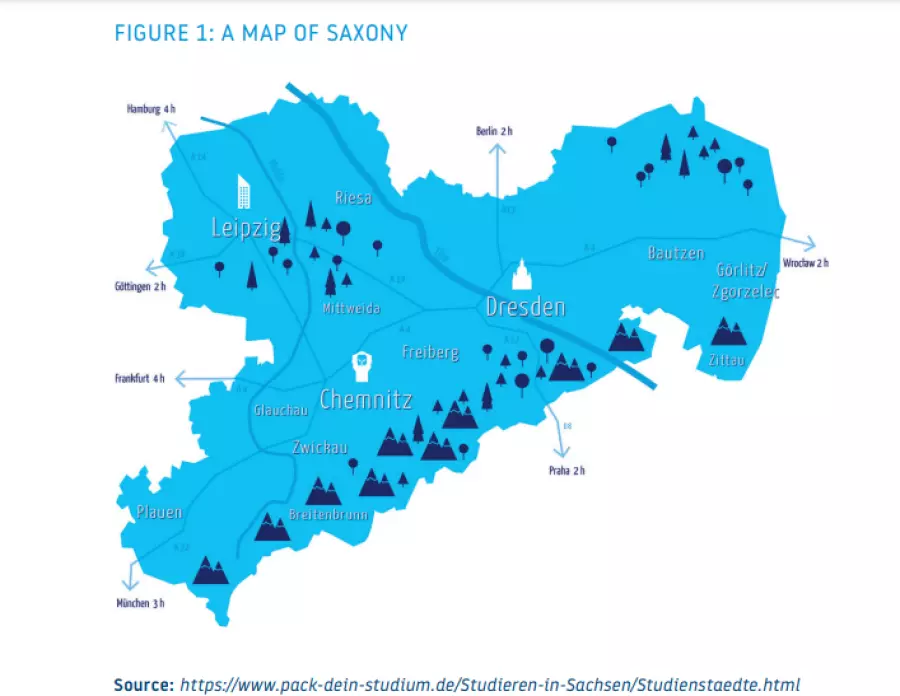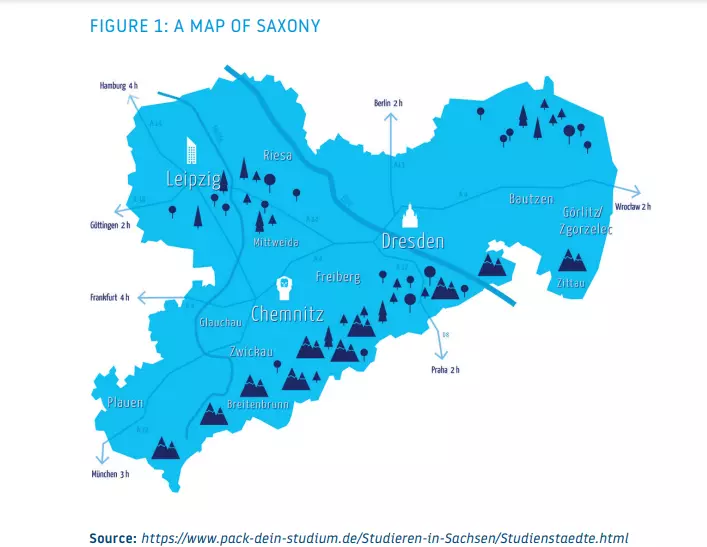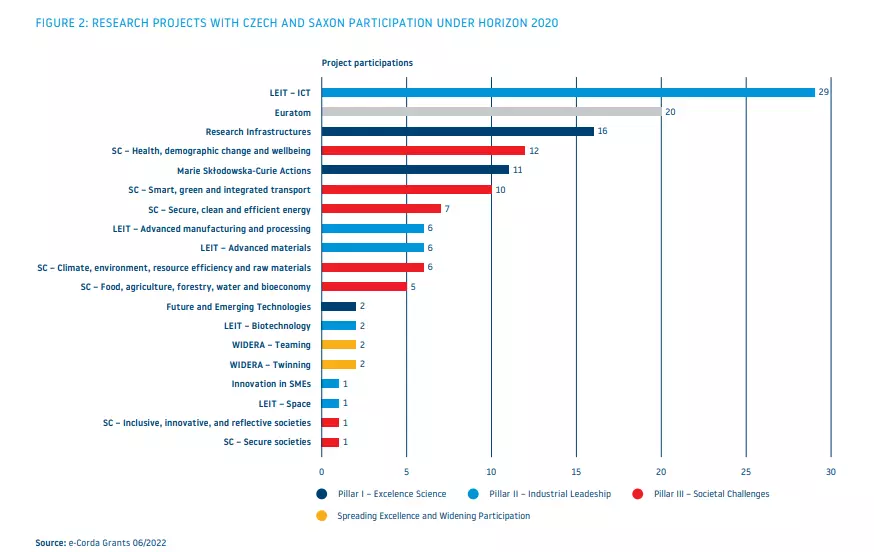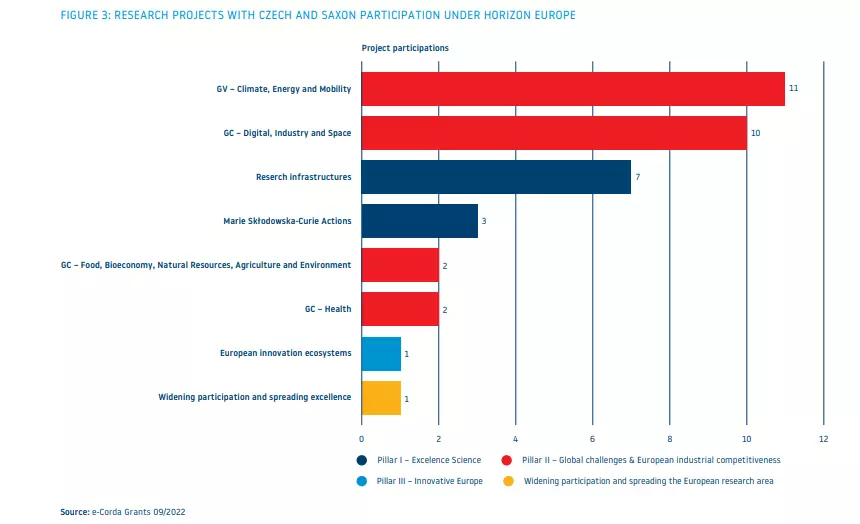
Získávání finančních prostředků z Evropské unie nabízí řadu potenciálních výhod. Žadatelé se však musí ponořit do složité struktury evropských strategií, dopadů a očekávaných výstupů projektů. Proto bychom my ze ZEUSS – Regionální podpůrné agentury ze Saska, chtěli představit naši instituci a sdělit nápady a náměty, jak pomoci našim dvěma regionům při propojování a sdružování společných kapacit.
Zeuss – A Regional Support Agency For European Research Projects
The European funding system for research and innovation is a very complex and multi-layered construct. For success, thorough planning as well as a strong and trustworthy cooperation among the collaborating international partners are necessary.
Advisory institutions can provide some guidance and assistance for researchers to get a clearer view of the possible funding schemes as well as what the required elements for a successful grant proposal look like and how to get them. In addition to National Contact Points, there are a handful of regional support agencies in Germany, who also offer such services in closer proximity to interested applicants.
And as such do we – ZEUSS the Saxon regional support agency – would like to take this opportunity to introduce our institution to a Czech audience. ZEUSS is a central EU Service institution for the German region of Saxony – one of the neighbouring regions of the Czech Republic. Established in 2016, it is an initiative of the Saxon State Ministry for Science, Culture and Tourism and offers support to obtain funding under Horizon Europe, the EU Framework Programme for Research and Innovation.
Our main objective is to enhance the participation of institutions in Horizon Europe as well as to improve success rates through comprehensive advisory services. Here, we mostly focus on public universities and research institutes. Another important part of our work are networking activities to connect Saxon researchers with international complementary partners to guarantee well-functioning and skilled consortia.
ZEUSS offers advice and support on all levels of an EU project – from the first notion of the call to the final report of the successful project. The following lists provides an overview of our services:
- Information on grant opportunities in Horizon Europe
- Individual consulting and evaluation of project ideas for applicants on site
- Assistance with the selection of appropriate funding calls
- Tailored support during the application writing process
- Agreements, management and administration of successfully acquired projects
- ZEUSS as beneficiary supports Coordinators in WP project management
- Support in reviewing the Evaluation Summary Report (ESR)
- Networking and information events
- (international) partner search
To give a better view into our expertise and our background, we also want to introduce the key people behind our institution. Gretel Wittenburg, human biologist, has received her PhD 2011 in translational life sciences focused on regenerative therapies and medical technology development. She is an expert in research funding advice and provides hands-on support to senior academics on large strategically-important projects. She develops and implements sustainable strategies building on research strengths, individual expertise and technology transfer options.
Alexander Hesse has a strong background in engineering and achieved his diploma as engineer in Transport Engineering and a Master in Spatial Development and Natural Resources Management. In addition to several years of professional experience in the industry, he also worked in the academic research sector (Mining University of Freiberg, Technical University of Dresden) in the field of international and national fundraising.
Christin Weigel has an educational background in foreign languages and business, and obtained a Master of Arts in European Studies in 2018. Christin gained experience in international cooperation and event management working for several Saxon Ministries, as well as TU Dresden’s Institutes for Biotechnology and for Chemistry. As a work package leader in the European Research Area (Cofund) for Biotechnologies ERA CoBioTech, she worked to align different European strategic funding instruments in the European Biotech Hub.
Research landscape in Saxony: Introduction to the Main Players and Thematic Focuses
Saxony has a rich and diverse research landscape with institutions that have a nationally and internationally proven research strength as well as being highly successful in attracting third-party funding [1]. The spectrum of the research ranges from basic research to applied research and development for industry.
There are a total of nine public universities as well as five art colleges. In addition to these public universities, there are state-recognised universities in private or church sponsorship as well as universities of administration which cover studies in artistic, social, technical or economic fields.
There are four top-performing, traditional universities, which are also the largest research institutions in Saxony. Together, the four universities in Dresden, Leipzig, Chemnitz and Freiberg cover nearly the entire spectrum of scientific fields, from engineering, natural sciences, humanities and social sciences to economics and law. Since 2012, the Technical University of Dresden has been one of eleven German universities of excellence [2]. In comparison to the four universities mentioned above, the five universities of applied sciences in Dresden, Leipzig, Mittweida, Zittau/Görlitz and Zwickau have a predominantly practice-oriented focus on teaching and research tasks. They joined forces to build the trans fer network “Saxony5”. It bundles their resources and competences to strengthen research-based knowledge and technology transfer on national and international level [3].
Outside of universities, there are approximately 50 research institutions who work in a wide thematic range, such as micro- and nanoelectronics, material sciences, production technologies, energy, environmental sciences, biotechnology, natural sciences, medicine, humanities and many more. These include the centres and facilities of the Helmholtz Association, the institutes of the Max Planck Society, the Fraunhofer Society, the Leibniz Association as well as the locations of three German Centers for Health Research, the National Center for Tumor Diseases and the German Aerospace Center (DLR) [4].
Many of those institutions and their research are being funded by the Free State of Saxony and/or the federal government of Germany. However, the project funding acquired within the European framework program for research and innovation is particularly noteworthy. Since 2014, Saxon institutions have obtained more than 660 million euros in EU funding with 1.042 successful projects in Horizon 2020 [H2020 eCorda 06/2022] and its successor Horizon Europe [HE eCorda 09/2022].
Measured by the participation in projects, the strongest thematic areas of the European research projects are digitalisation and ICT, climate and environmental research as well as health and energy. Saxon researchers are also very active in the open-topic funding schemes of the European Research Council, which aims at strengthening excellent basic and frontier research as well as the Marie Skłodowska-Curie Actions, which promote transnational and intersectoral mobility and career development of researchers [H2020 eCorda 06/2022] [HE eCorda 09/2022].
In the field of digital and ICT the institutions with the most project participations are the Technical University of Dresden, the Fraunhofer Society and the University of Technology Chemnitz. The main players within the research of climate action, environment, resource efficiency and raw materials are the Helmholtz Association, Technical University Bergakademie Freiberg (Mining Focus) and the Leipzig University. In both the health and energy fields, the Technical University of Dresden, the Fraunhofer Society as well as the Leipzig University are strongly represented [H2020 eCorda 06/2022] [HE eCorda 09/2022].
Neighboring regions – a natural breeding ground for cooperation? A look on joint research so far
After giving an overview of the research landscape of Saxony it is now interesting to take a look at the research cooperation between the Czech Republic and Saxony so far.
Looking at the cooperation within the European framework program for research and innovation, there have been a total of 177 projects involving institutions from both regions with a combined EU contributions of almost 112 million euros since 2014.
As can be seen in the two diagrams below, the thematic scope of their collaboration is quite broad. In both, Horizon 2020 and Horizon Europe, there has been a high participation in the research fields of digitalisation and ICT, climate and environmental research as well as energy and transport. Furthermore, the two regions received funding for doctoral education and postdoctoral training within the Marie Skłodowska-Curie Actions.
A prime example of for a successful joint project is the European network of public funding organisations “M-ERA.NET”. The network seeks to support and increase research and innovation related to materials and battery technologies through coordination and convergence of national and regional funding programmes. In support of the European Green Deal, annual joint calls are implemented to tackle materials challenges for the 21st century, including the reduction of greenhouse gas emissions and the sustainable production of energy and materials. First funded under the FP7, it continued running in Horizon 2020 and is now in its third phase as M-ERA.
NET 3 until 2026. The consortia currently consist of 49 public funding organisations from 35 countries [7]. In the second phase, which ran from 2016 to 2020, 172 transnational projects were funded with a total of 125 million euros [8].
Another example from a different research field is “SPOT” – Social and innovative Platform On cultural Tourism and its potential towards deepening Europeanisation. The EU-funded project aims at a new approach to understand and address cultural tourism while also promoting the development of disadvantaged areas as well as “explore emerging forms of cultural tourism, identifying opportunities and developing strategies to allow local people to gain benefit from their precious cultural assets” [9]. In its form, it is the first attempt to capture the concept of cultural tourism in a widened sense on an international basis across Europe. Within the project, they developed a GIS-based tool to support the decision-making for the development of cultural heritage attractions/sites. The building or improvement of cultural tourism sites are intended to contribute to a strengthened economic and social sustainability. It is accessible to the government, investors and the general public alike. Coordinated by the Mendelova univerzita v Brně, the consortium consists of 15 partners from 14 European countries and Israel [10].
Using the funding opportunities from the Marie Skłodowska-Curie Actions, “NaToxAq – Natural Toxins and Drinking Water Quality - From Source to Tap” is a European Training Network producing knowledge about natural toxins in aquatic environments. The aim is to do further research in securing high quality drinking waters. The network consists of 22 major research from 7 European countries and USA. It trains 15 PhD fellows in obtaining knowledge and skills needed to take the lead in this field “by investigating natural toxin emission via water reservoirs to water works and consumers” [11].
To conclude this section on joint cooperation projects, we have chosen one more example, which has just begun and will also offer good opportunities for future collaborations. The Clean Energy Transition (CET) Partnership is an initiative co-funded by the European Union and aims to foster the clean energy transition by bringing together national and regional budgets and implement annual joint calls. These calls provide the funding for technologies and system solutions required to make the transition. The plan is to create transnational innovation ecosystems with public and private stakeholders from European and non-European countries and regions. The initiative is a contribution to the goal of making Europe the first climate-neutral continent by 2050 [12].
So far so good – but what is still possible? Suggestions and potential for further cooperation
As seen in the previous chapter, there already have been a variety of successful research and innovation projects between the Czech Republic and Saxony in different fields and by using various instruments. Through regional proximity, the two neighbouring regions have the ability to build a natural network of scientific and eco nomic stakeholders. But what can be done to empower and foster further cooperation? And what topics and funds offer potential for it? In this last section, we would therefore like to give some impulses for a strengthened cooperation.
In 2021 the German Federal Ministry of Education and Research, in cooperation with the Free State of Saxony, organized the German-Polish-Czech Science Platform “Cross-border innovation for the Central European region(s)” in Dresden. As part of this platform, ZEUSS invited funding advisors and managers from the three countries to a network meeting. Representatives of the national contact points and other multipliers of EU research funding exchanged ideas in four moderated workshops on further opportunities for cooperation with regard to Horizon Europe. Most of the following ideas are taken from the workshop and are presented here in summarised form.
As the workshop was held from the point of view of the funding advisors, their role was an important talking point. Funding advisors and multipliers are experts on the various funding schemes and opportunities, thus providing interested researchers with the necessary knowledge on how to get funding, finding partners and how to handle a successful project. They can be a good starting point for getting various partners together for a joint research project. In order for this to be successful, the different National Contact Points, other advisors as well as the project offices of the research institutions have to be in contact with each other and be willing to work together. At the Science Platform in 2021, there was a huge interest for common cooperation as well as the opportunity to learn from each other. Some of the points discussed were for example the creation of different platforms to exchange ide as and expertise such as online share points and regularly meetings or brokerage events that are also open for a wider range of scientific stakeholders. A crucial factor is a well-trained and knowledgeable staff. Here, small training groups or a temporary staff exchange can help to share expertise.
The next step for funding advisors is then to make their services known to the researchers and make getting in contact and using the services easy. A professional management office as well as a targeted communication strategy is a must. This can be achieved with an up-to-date online presence on its own website and on social media. Regularly contact and communication with the research institutions and between the different support agencies is also essential. As a result of this exchange, gaps in knowledge and skills as well as the demand for further information can be determined. The support agencies of the regions can then organize joint information events, workshops as well as matchmaking events for the researchers to take part in, reducing the complexity of the various funding schemes and the inhibition threshold for participation in the programme. Those events are a great way to get to know the different researchers and the fields they are working in, which can pave the way for possible future cooperation.
Furthermore, incentives can help increase the cooperation. For example, financial support for the project proposal preparation can help to make it easier for institutions to consider even participating in a project. However, there are also problems and shortcomings with financial supports as well as the overall funding opportunities. Combining European funding opportunities with structural funds from federal or regional levels are not always compatible. On top of that, the distribution of structural funds in is different for the Czech Republic compared to Germany. Therefore, participation in competitive programmes such as Horizon Europe tends to be lower in the Czech Republic. To improve this situation, there is a need of streamlining the different funding schemes. Also, a bottom up approach and the role of researchers in conceptualising funding programmes for research and innovation should be strengthened.
Once the organisational and administrative framework for cooperation has been achieved, it is interesting to see in which areas cooperation can be interesting and profitable. Looking at previous successful research from both regions, possible fields of interest in Horizon Europe could be climate, energy and mobility research. Especially the recently started Clean Energy Transition Partnership (CETP) and the EU missions Soil, Cities and Adaption to Climate Change provide a basis for innovative projects. As already mentioned, the Czech participation in the Horizon programme tends to be lower than the German participation, the funding opportunities of the programme pillar “Widening participation and spreading excellence“ should be explored further. The actions under that pillar are designed to contribute to building research and innovation capacity for countries lagging behind, strengthening “their potential for successful participation in transnational research and innovation processes, promote networking and access to excellence” [13]. The participation of Saxon institutions in those actions has not been that high so far. However, it offers a huge potential to learn from each other, for example through the creation of centres of excellence or the enhancement of networking for excellence through knowledge transfer and exchange of best practices. The special feature of this funding scheme is that the coordination of a project has to be done by a so called “Widening country”, of which the Czech Republic is one, thus giving those countries the opportunity to bring their ideas and impulses to the centre of attention. On the topic of knowledge transfer and learning from each other, the Marie Skłodowska-Curie Actions could offer another possible cooperation option. With them the European Commission supports “researchers from all over the world, at all stages of their careers, with a focus on their training, skills and career development” [14]. Not only will it help the individual scientist, but also strengthen the involved organisations and building international links.
The possibilities for joint research projects seem to be rich and diverse. There are a number of funding schemes and instruments which offer a nurturing ground for successful joint research in a variety of fields. What is necessary however, is a constant communication with each other, the willingness to participate and to accept help from each other as well as keeping an open mind for possible adjustments and new ideas. With this statement, we would like to conclude this little introduction to ZEUSS and the opportunities for research cooperation between our neighbouring regions.
We hope we have sparked an interest in our work and our efforts to bring our two regions even closer together in order to get more funding for successful research and innovation projects. If you have ideas and an interest in working together with Saxon researcher, please do not hesitate to get in contact with us – either through your national contact point or you can find our contact information on our website: www.zeuss.sachsen.de/en/. Let’s start it together! We look forward to your message!
Autorka: Gretel Wittenburg
Zdroj: Technologické centrum Praha
Text vyšel v časopise ECHO (3/ 2023), který vydává Technologické centrum Praha.
- Autor článku: ne










































